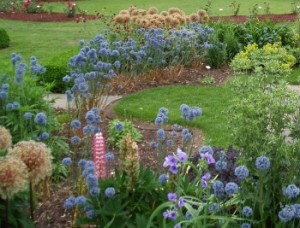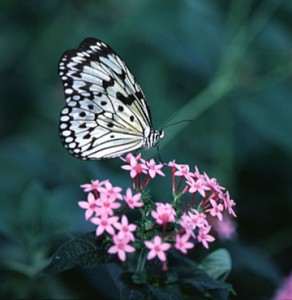





There is an archetypal image of the ideal country garden; from a sleepy lane, a gate in a low wall shows a broad flagged path leading to the venerable door of a black and white thatched cottage. The path is cascaded with flowers, pinks burgeon from cracks in the paving and roses are so prolific over the porch that everyone of normal size has to go round to the back door. The idyllic picture is not without validity but it should be realised that such effects are in almost every case the product of much care and hard work and that they are also the result, not of romantic recreation of a past period of rustic perfection but 20th-century gardening in one of its better forms.
The important point is that it is lovely to look at and that it works by giving the impression of being absolutely right in its context. This surely is one of the main criteria of garden success in any context. In the country, fitting a garden into its scene is particularly important. But we do not all live in black-and-white-timbered cottages. Outskirts of country towns and villages are now peppered with contemporary houses and bungalows in the conventional convenient style which hardly varies throughout the country.
 What does help always to settle a house into its site, is a successful garden. In towns and built-up areas there is little need to worry greatly unless there is a definite local style or material to build upon. In the country making an effort to fit in with the scene is so much more important; if there is a local stone available at a reasonable price it really should be used for garden walls or paving. Sometimes, as in the Cotswolds, there is good (and bad) artificial stone, coloured to fit in with old buildings. In many cases, unfortunately, houses and walls constructed of such material do look very brash — perhaps we should wait without impatience for time to mellow them but meanwhile luxuriant planting will help a lot. This is especially necessary at points where a new wall joins an old one.
What does help always to settle a house into its site, is a successful garden. In towns and built-up areas there is little need to worry greatly unless there is a definite local style or material to build upon. In the country making an effort to fit in with the scene is so much more important; if there is a local stone available at a reasonable price it really should be used for garden walls or paving. Sometimes, as in the Cotswolds, there is good (and bad) artificial stone, coloured to fit in with old buildings. In many cases, unfortunately, houses and walls constructed of such material do look very brash — perhaps we should wait without impatience for time to mellow them but meanwhile luxuriant planting will help a lot. This is especially necessary at points where a new wall joins an old one.
While a traditional cottage garden can take a riot of summer colours because of its essential unsophistication, it is very difficult to obtain such an effect by design. Better to go about things rather more quietly, especially if a new house is not to over-assert itself. While not advocating a pedantically purist approach it is safe to suggest that the more strident effects of the hybridists’ art, ‘Super Star’ roses, Prunus ‘Kanzan’, Salvia splendens cultivars and so on, do look over-aggressive in the country. Gentler reds amongst modern hybrid tea roses such as ‘Fragrant Cloud’ and ‘Rosemary Rose’ fit in much better, as does Prunus sargentii which also has a bonus of magnificent autumn colour.
There is always attraction and charm in so-called old-fashioned flowers. The term is pretty vague and is apt to include a lot of things which our ancestors never knew: its antithesis, however, is clear enough and two or three examples of such plants are mentioned above. What are meant, obviously, are plants of the countryside (ours and other people’s); foxgloves, auricular, dog daisies, hollyhocks, pinks, polyanthus, Madonna lilies amongst herbaceous planting. Shrub roses, philadelphus, hydrangeas and fuchsias come to mind amongst shrubs. This is not to suggest leaving out hosts of garden-worthy plants from all over the world, possibly of quite recent introduction. In general, as one might expect, plants of wild origin — those referred to as species — are likely to fit in the best.
One of the particular pleasures of country gardening to most people is the variety of wild life which becomes associated with the garden. Smiles become a little forced when mice eat every crocus corm and blackbirds start queuing up at the one tear in the raspberry netting, but these are universal rural hazards. Some form of modus vivendi is certainly necessary both in town and country, and that is to grow all soft fruit, except gooseberries, in a cage. Modern models, with metal uprights and nylon or polypropylene netting easily removed and stored after the fruit has been picked, are expensive but effective and long lasting. In some areas similar protection will have to be given to brassica crops from voracious pigeons, especially in winter if a single Brussels sprout is to be picked. Only tightly strung black cotton has any real effect, though it has to be renewed quite often. Scarecrows and various windmills are usually more fun for the children than a deterrent to the birds.
To look on the bright side, encouraging a range of beautiful and beneficial birds is both sensible and a pleasure. To watch blue tits scouring twigs and branches of trees is to realise what huge quantities of insects they consume. In addition, then, to the obvious bird table and water bath placed a couple of yards from a window where it is easily seen, a range of plants may be chosen to increase bird life. Tight laid or clipped hedges offer nesting sites, as do wall climbers and nesting boxes can be added. Autumn berrying shrubs such as cotoneasters, pyracanthas and berberis will attract finches. (If you don’t want the berries eaten it is wise to plant yellow-fruited forms: birds leave these alone for months, presumably thinking them unripe.) Incidentally, greenfinches will gobble up every berry of Daphne mezereum as soon as it is ripe in August.
While the tamer birds will come to a fully exposed bird table, it will be used regularly by shy species if there is a nearby tree or large shrub for them to perch in and be sure the coast is clear and cat free before flying down. A range of food will encourage a diversity of feeders. Unfortunately starlings and sparrows are now learning a few acrobatics, once the preserve of the tits, that will provide them with equally high-grade protein as they steal nuts and fat from hanging containers. Ring the changes here and the tits will usually find the new food source that little bit quicker. The simplest form of bird table is just a board 45 by 30cm (18 by 12in) with a small branch attached on a leg 1.4 to 1.5 m (4ft 6in to 5 ft). This is sufficient to hold the food and a bowl of ice-free water. Birds are not better served by a pretty thatched house on a stick; on the contrary they are less able to watch out for predators.
While it is delightful, especially in really cold weather, to know that one is really helping the survival of small birds, it is reasonable to expect something of a return on the family nut-fund. Feeding should cease when spring has really come in order that the birds should contribute to the general balance of nature in the garden by eating aphids and other insects.
 Fortunately not all insects are harmful and, of these, butterflies are not generally eaten by birds. So there is no clash of interests if there is an attempt to encourage butterflies into the garden. One of the great pleasures of late summer and early autumn — now sadly reduced from a couple of decades ago — is the number of tortoiseshell, red admiral and peacock butterflies feeding from the flowers. Certain species are known to be especially attractive to them – buddleia is not known as butterfly bush for nothing. So to group a buddleia (B. fallowiana ‘Lochinch’ or B.f. Alba are smaller, choicer forms with good grey foliage) with Sedum spectabile and early Michaelmas daisies will ensure that some of the butterfly population visit the garden.
Fortunately not all insects are harmful and, of these, butterflies are not generally eaten by birds. So there is no clash of interests if there is an attempt to encourage butterflies into the garden. One of the great pleasures of late summer and early autumn — now sadly reduced from a couple of decades ago — is the number of tortoiseshell, red admiral and peacock butterflies feeding from the flowers. Certain species are known to be especially attractive to them – buddleia is not known as butterfly bush for nothing. So to group a buddleia (B. fallowiana ‘Lochinch’ or B.f. Alba are smaller, choicer forms with good grey foliage) with Sedum spectabile and early Michaelmas daisies will ensure that some of the butterfly population visit the garden.
Reduction in their numbers is commonly, and in the main rightly, blamed upon the general use of insecticides. Another is the over-zealous gardener and also the over-tidiness of local councils who immorally spray herbicides on road banks and hedgerows. It is generally forgotten that these butterflies, elegantly sipping at nectar, are the product of their caterpillar larval stage, heartily champing at nettle leaves. A patch of nettles, then, in a corner of the orchard or against a hedge could be the source of much autumn pleasure. It is also the source of a spring vegetable: boiled nettle tops, very young, are not at all bad.
Copyright © www.100flowers.win Botanic Garden All Rights Reserved